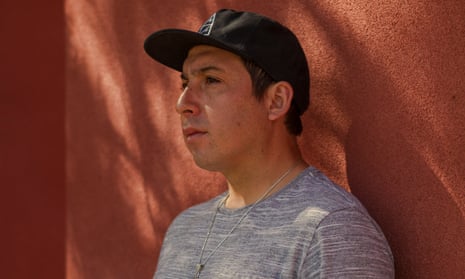Tommy Orange is a Native American writer. He teaches creative writing at the Institute of American Indian Arts and his debut novel, There There (Harvill Secker, £14.99), is a New York Times bestseller.
There There is about urban Native American lives. Are these lives and experiences under-represented in fiction?
Yes, you already find Native people in fiction, but there aren’t many representations of us as modern, contemporary and living in cities, so that was definitely something I saw lacking.
What made you decide to have 12 narrators?
I really liked what a chorus of voices could do. I like, within a novel, to jump around and see how the different voices connect. It gives the reader a lot to do. And when the reader gets the connection, something really special happens: like a clicking in place. It gives it a kind of propulsion and makes it a really active reading experience.
Did you also want to portray as many different Native urban experiences as you could?
I guess so. There’s a monolithic version of what a Native is supposed to be. Writing a polyphonic, multigenerational novel is resisting this one idea of what being Native is supposed to look like. If we all have to be historical, with a headdress, looking off into the distance, that’s hopeless as far as building a proper, complex, human identity.
Many of your characters are deeply troubled. Why?
I wanted to write characters that felt true and real, and there’s a lot of harrowing detail about the lives of Native people. You can just look at the health statistics and they’re pretty staggering. I wanted the characters to be working-class, because so often the characters in novels that I’ve read are white and upper-middle-class with white, upper-middle-class problems. I didn’t want to go anywhere near the old romanticised view of the Indian as the warrior, the powerful, the unflinching, the brave. That just doesn’t feel whole to me.
The title is taken from a Gertrude Stein quote: “There is no there there.” What’s the significance of that quote?
In Stein’s Everybody’s Autobiography, she talks about how someone was asking her what it’s like to come back to her childhood home in Oakland, where I also come from, and she says, “There is no there there.” She was talking about how it had been developed over and was unrecognisable. I was using that as a parallel to Native experience and the “there there” of the land before it was colonised, developed over and bordered.
The novel explores what it means to be Native American today. What does it mean for you?
It’s meant a lot of different things over the years. Currently it means going back to see my dad, who lives in Oklahoma now, and slowly trying to learn the language, because while he’s fluent he didn’t raise us with it. It means making sure my son knows that he’s Native too. It’ll keep meaning more things along the way.
Why didn’t your dad teach you the language?
There’s a lot of pain related to the past, and I think he was wanting a fresh start, wanting to raise us in Oakland and have us figure it out for ourselves. I think if we had been born in the 21st century to a dad who was fluent in Cheyenne, we probably would have been taught it from an early age. But my dad had a lot of pain in his childhood. It was a time of assimilation.
Which writers have most influenced your writing?
Clarice Lispector was a pretty big influence. Also, Andrei Platonov, Denis Johnson, Louise Erdrich, Roberto Bolaño, Haruki Murakami.
What’s the book you most like to give to people as a gift?
Clarice Lispector’s The Hour of the Star.
Is there a classic that you’re ashamed not to have read?
I skipped a lot of the classics because I didn’t read in school, and I don’t really feel like I’m missing out. Sometimes I’ll try to go back and read older stuff, but I get really bored with old voices.
What’s next up on your reading list?
I’m reading a book by Katherena Vermette called The Break and it’s been compared to mine because it has a whole bunch of different voices: it’s urban and it’s Native but it’s set in Winnipeg.
Given that publishing is historically white and middle-class, do you think it’s an ongoing challenge to get more diverse voices into fiction?
There’s a change going on and it’s related to Trump. People are coming to terms with a really ugly, white supremacist, racist side to our country and our history, and so I think although publishing’s still super-white, there’s a lot of people wanting to bring in diverse voices. The fear for me is that if we don’t change the institution of whiteness in the publishing industry as a whole, the trend will change and there’ll be a backlash. You know, you have people like Lionel Shriver who are claiming that diversity over excellence is harming literature as a whole, as if the diverse voices that are being heard right now are only getting published because of their diversity. It’s so depressing to hear that because as a person of colour publishing now, there’s always the fear of tokenism and this fear that you’re not being published on the merit of your work. And then you hear people like Shriver and you think: “Yeah, that’s what we suspected.”

Comments (…)
Sign in or create your Guardian account to join the discussion